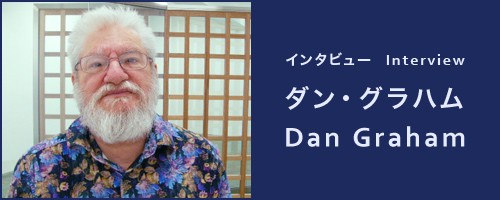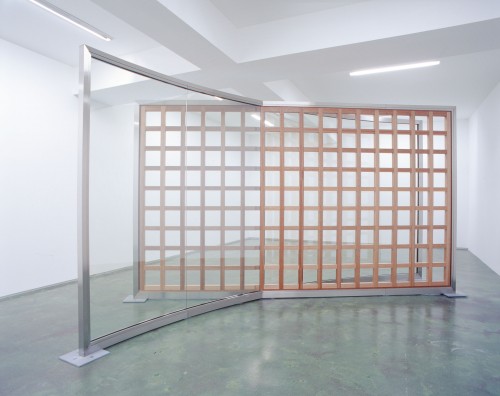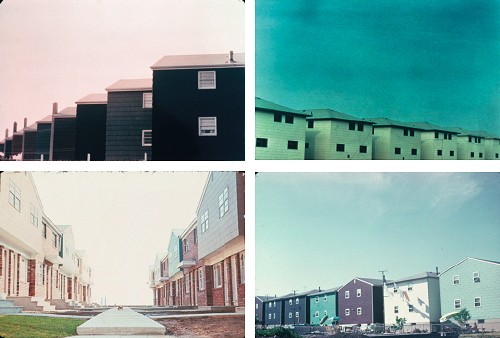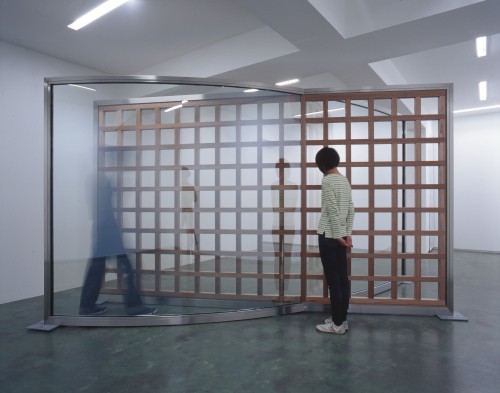The whole idea of conceptual art being about philosophy is bull; humor is more important.

Proponent of conceptual art, pioneer of contemporary art, prognosticator of post-conceptualism… Countless phrases have been turned to sum up Dan Graham, but none quite like ‘the man who brought minimalism and pop together with rock to make punk – philosophically, at least.’* Just as rock shook its generation, and punk overturned established notions, the products of Graham’s more than 40-year practice have always been a radical voice of their times.
Interview/text: Nishimura Daisuke (Someone’s Garden)

Wood Grid Crossing Two-way Mirror 2010
Aluminum, wood, two-way mirror glass 230 x 400 x 140 cm
Installation view at Taka Ishii Gallery, Tokyo Photo KEI OKANO
– You were born in Illinois, the land that produced American icons the likes of Miles Davis, Walt Disney, and Ronald Reagan. While I imagine some your artistic tendencies may be rooted there, you also moved to New Jersey when you were three. What would you say were the biggest influences of your childhood?
Well, my mother was an educational psychologist and a student of Kurt Lewin, the founder of group dynamics who used topology diagrams to show social and psychological interactions. My father was a chemist, and was very abusive to me. Then when I was in high school I had a psychotic breakdown, and thought everything was nausea, and that experience led me to read Sartre. Strangely I later learned talking to Paul McCarthy that his troubles in high school led him to read Sartre – so there was an affinity (laughs).
– What inspired you to start making art?
Feminism for one thing. Women became very powerful in America in the 1940s. Eleanor Roosevelt, who became a lesbian by the way, promoted the United Nations and while married to FDR, became very powerful on her own. But most important was discovering books by the cultural anthropologist Margaret Mead on my parents’ bookshelf when I was thirteen. Mead was very involved with sexuality, and studied matriarchal societies in places like Melanesia.
The road to Dan Graham-style conceptual art
– Tell us about the origins of your early iconic Homes for America (1966-67) photographs and the conceptual magazine piece Side Effects/Common Drugs (1966).
In 1964 I opened the John Daniels Gallery in New York where I showed minimalist artists, but the gallery went out of business, so I moved back to my parents’ place in the suburbs. It was along the railroad from Manhattan to New Jersey that I spotted those houses, so I walked along the railroad and took photographs. Then during a show called Projected Art, where they were shown just as slides, Arts magazine approached me about publishing them. But I think people misunderstand Homes for America. It’s about the poetry of the suburbs, about the suburban city plan, rather than the white cube.
Side Effects/Common Drugs, in ’66, was based on the Rolling Stones’ ‘Mother’s Little Helper’. The humor is that you take one drug, and then have to take another drug to counteract the effect.

Homes for America 1966-67
Twenty 35mm slides and carousel projector Dimensions variable
Courtesy Taka Ishii Gallery, Tokyo and Marian Goodman Gallery, New York

Side Effects/Common Drugs 1966
Offset lithography on paper 46 x 30 inches
Courtesy Marian Goodman Gallery, New York
– You now work across a wide range of media, but I believe video played a key role in the process of developing what has come to define your style…
It started when I was reading a video magazine, and discovered that a lot of video work was about psychological models and group models. David Askevold, who was teaching at the time, invited conceptual artists to propose ideas for projects that students could realize. So I went to work with the students because I knew I could use their equipment. I had stopped doing conceptual art around ’69 because I didn’t like the conceptual artists – they took a lot of ideas from me (laughs). The whole idea of conceptual art being about philosophy was bull; I thought humor was more important. Great art always has humor.
Communion with the New York music scene
– How, by the way, did you get hooked up with Kim Gordon, one of the key figures of the contemporary youth music scene?
Actually when I met Kim Gordon she was really lost. Her boyfriend (and teacher at Otis) was going to come with her to New York but didn’t, so he told her to look me up. She said, ‘Dan, I’m a Taurus – that means I’m too close to people psychologically and can only be a helpmate.’ She had no sense of herself. So I said ‘Freud was a Taurus, and he was close to people psychologically, and he wanted to help them.’ I told her to write, because Freud was a great writer. Kim and Thurston Moore later lived for a long time in the apartment below mine. She also did some of the music for my video Rock My Religion (1984).
Performance by Mirror/Dash (with Kim Gordon and Thurston Moore) at the opening of Dan Graham: Beyond at MOCA Grand Avenue (14 Feb 2009).
See Rock My Religion at http://www.ubu.com/film/graham_rock.html
– Some people call you the philosophical father of the punk scene…
Well, I was a fan of the Ramones and I used to go to CBGB a lot. And in the ’70s, I think some of punk had humor. I don’t usually go to clubs and I don’t drink, but in those days I used to get guest passes so I went to see a lot of performances. I think it was very much about community. Punk had a spirit of resistance – although my work was probably closer to hippie. But hippie culture became exclusive – from Jackson Browne on down – it was all about the self. Punk was reaction against that. It was trying to get rid of the pretentious singer-songwriter.
Approaching the architectural: the pavilions
– What inspired you to start making sculptures that cross art and architecture?
I had been working with video time delay in 1976 when I was invited to be in a show in Venice, where for various reasons I couldn’t use video. So I conceived a white cube, where I took out one white wall and made it a window. Two years later I was asked to do a show at Modern Art Oxford, and saw that architects were showing models in galleries, so I had the idea of doing eight architectural models. Some were pavilions and others were fantasies for suburbia. What I liked was that they were hybrids between art and architecture. So that’s how the architectural works began.
– Your new pavilion at your solo show here is Tokyo is outstanding…
Children seem to like it too. I usually show these pieces outside, but this one works well inside the gallery too. As you walk around it you can see yourself distorted. So it’s more important that you walk, rather than stop and look at it. I made it partially wood because I had experimented with grids before for a piece I did for the Yamaguchi Prefectural Museum – I was thinking of a Japanese shoji screen without the paper.

Wood Grid Crossing Two-way Mirror 2010
Aluminum, wood, two-way mirror glass 230 x 400 x 140 cm
Installation view at Taka Ishii Gallery, Tokyo Photo KEI OKANO
– Lastly I’d like to know what kind of art you think is needed today?
Minimalism was about the here and now, the moment. I like the ‘just past’. The work I did in the ’80s in landscape architecture related to the different historical periods of park design in Europe. So as I get older, I’m thinking that it’s very important to have a historical basis, but not necessarily in art. I think landscape architecture and the city plan are very important. The problem is that everything is neo-sixties. People oversimplify things from the sixties. I think what’s important now is much wider than the fantasy of the sixties.
*http://www.nj.com/entertainment/arts/index.ssf/2009/06/whitney_museum_to_celebrate_da.html
Dan Graham
Born 1942 in Urbana, Illinois. Based in New York. While working as an art critic in the 1960s, Graham presented works on the pages of magazines. In the ’70s he moved into video installations and performances, and from there to producing pavilions that cross sculpture and architecture. In all of their incarnations his works have dealt with conceptual subjects. His 2009 retrospective Dan Graham: Beyond toured the Museum of Contemporary Art, Los Angeles; the Whitney Museum and the Walker Art Center. He has also been deeply involved with rock music, and in 2009 published the essay collection Dan Graham: Rock/Music Writings. His solo show at the Taka Ishii Gallery (Tokyo) runs 20 February – 27 March.
